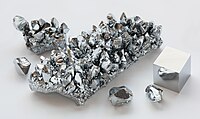
Photo from wikipedia
Abstract Laser cladding followed by machining is nowadays a process chain widely utilized in the metal manufacturing industry for restoration of high-value components and optimization of the mechanical and corrosion… Click to show full abstract
Abstract Laser cladding followed by machining is nowadays a process chain widely utilized in the metal manufacturing industry for restoration of high-value components and optimization of the mechanical and corrosion properties of poorly performant alloys. In this paper, C45 steel substrates were laser cladded with multiple layers of AISI H13 tool steel. First, the powder granulometry, scanning speed, and laser power were varied to obtain homogeneous and fully dense claddings with high hardness. The number of deposited layers was then varied using the optimized laser cladding parameters and its effect on the claddings quality was assessed both in the as-built and machined conditions. A detailed characterization was carried out considering macrostructural and microstructural features, porosity, and microhardness, taking into consideration also geometrical and topographical characteristics. This study shows, for the first time, a robust correlation between the number of layers and the cladding characteristics both before and after machining. In particular, a reduced number of layers was proved to lead to a better quality of the as-built claddings, but negatively affects their machinability.
Journal Title: Cirp Journal of Manufacturing Science and Technology
Year Published: 2021
Link to full text (if available)
Share on Social Media: Sign Up to like & get
recommendations!